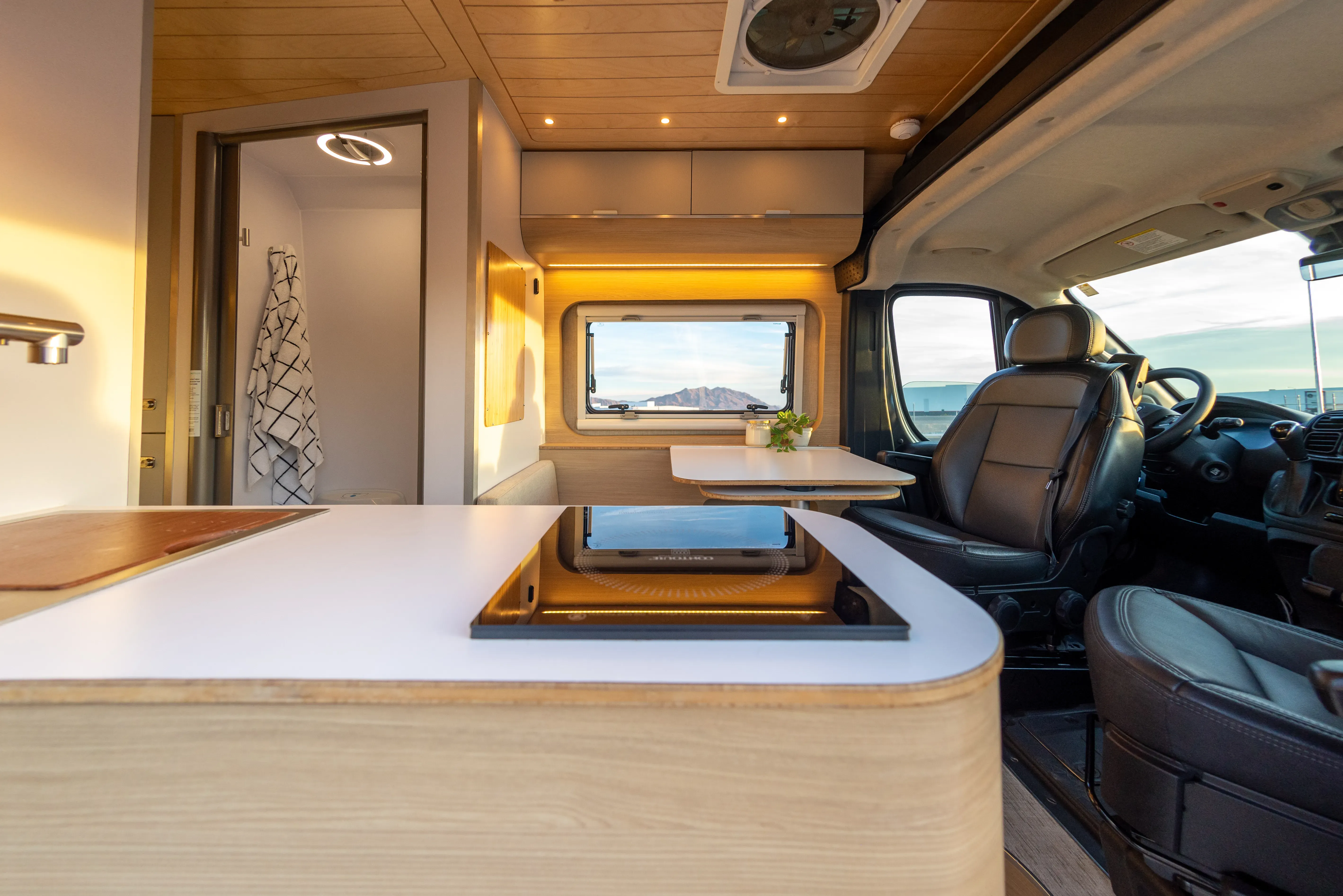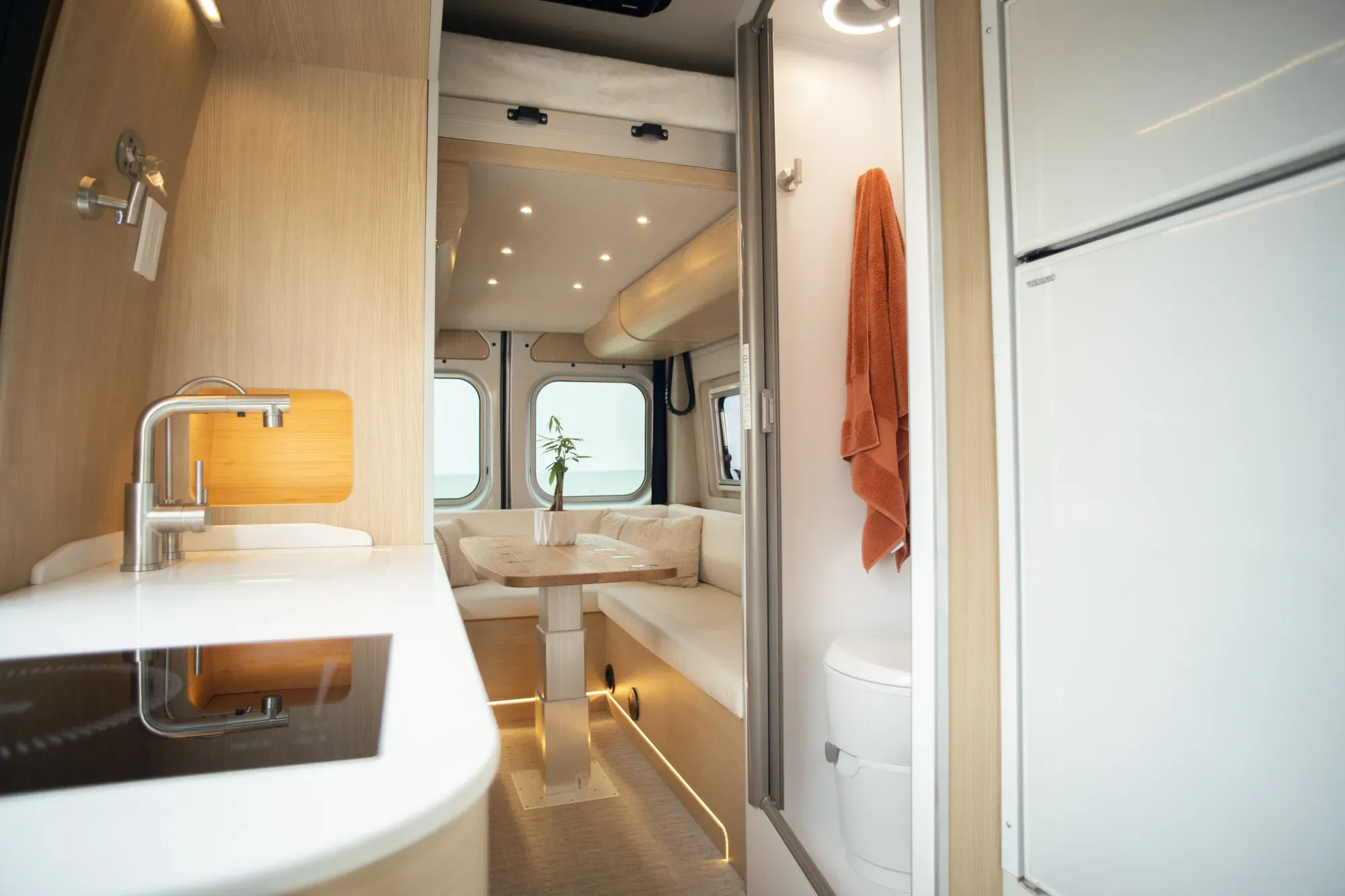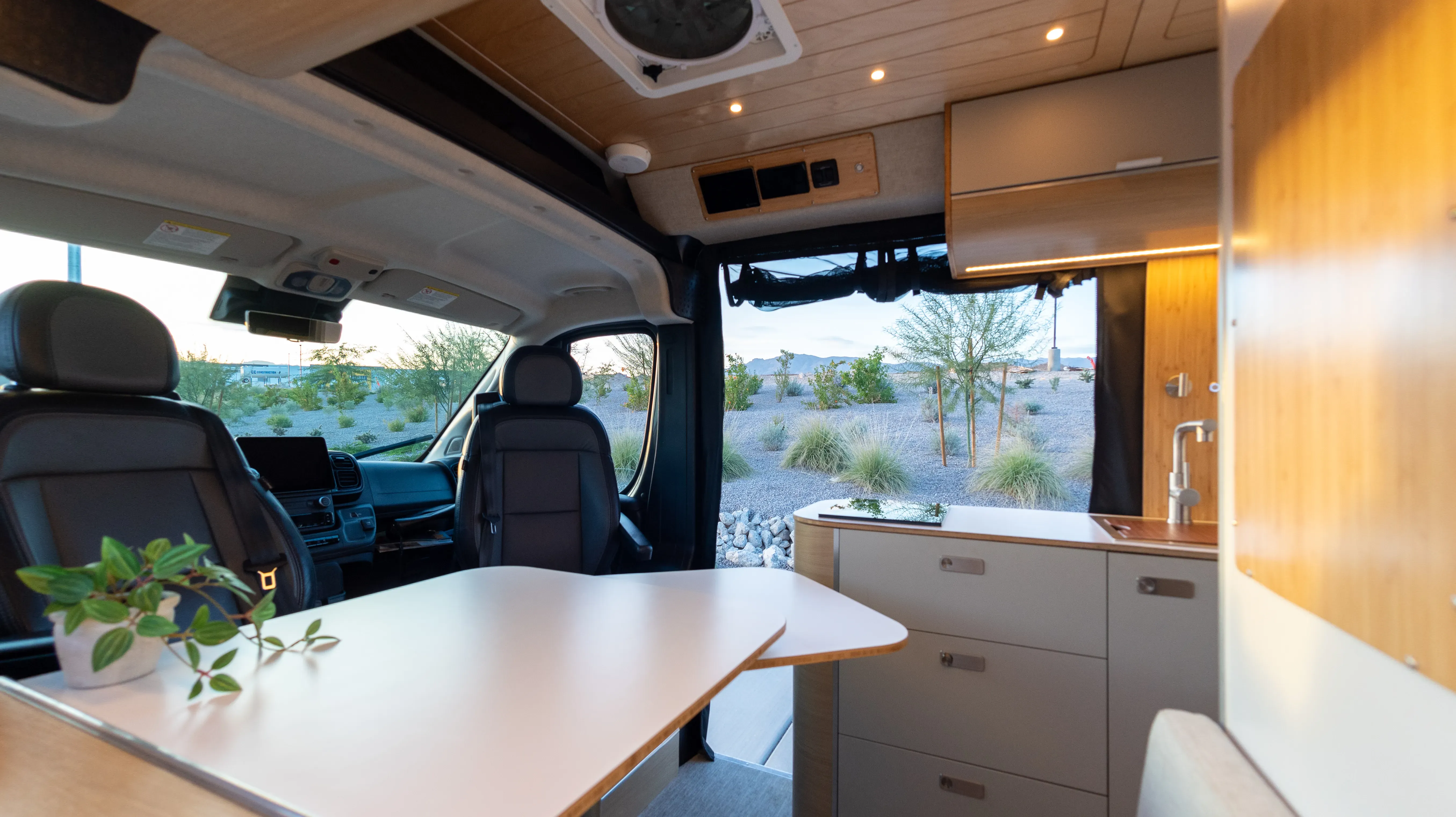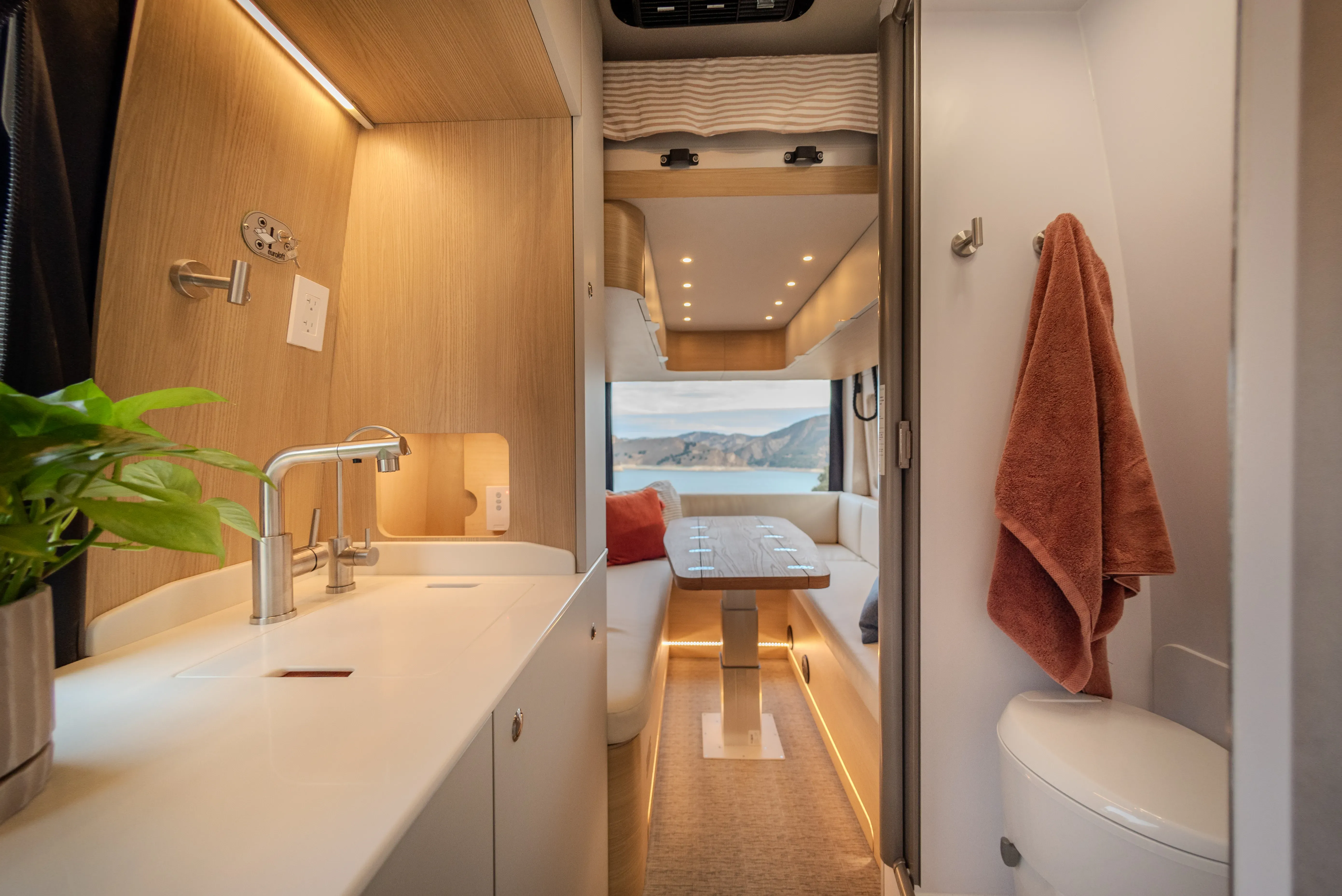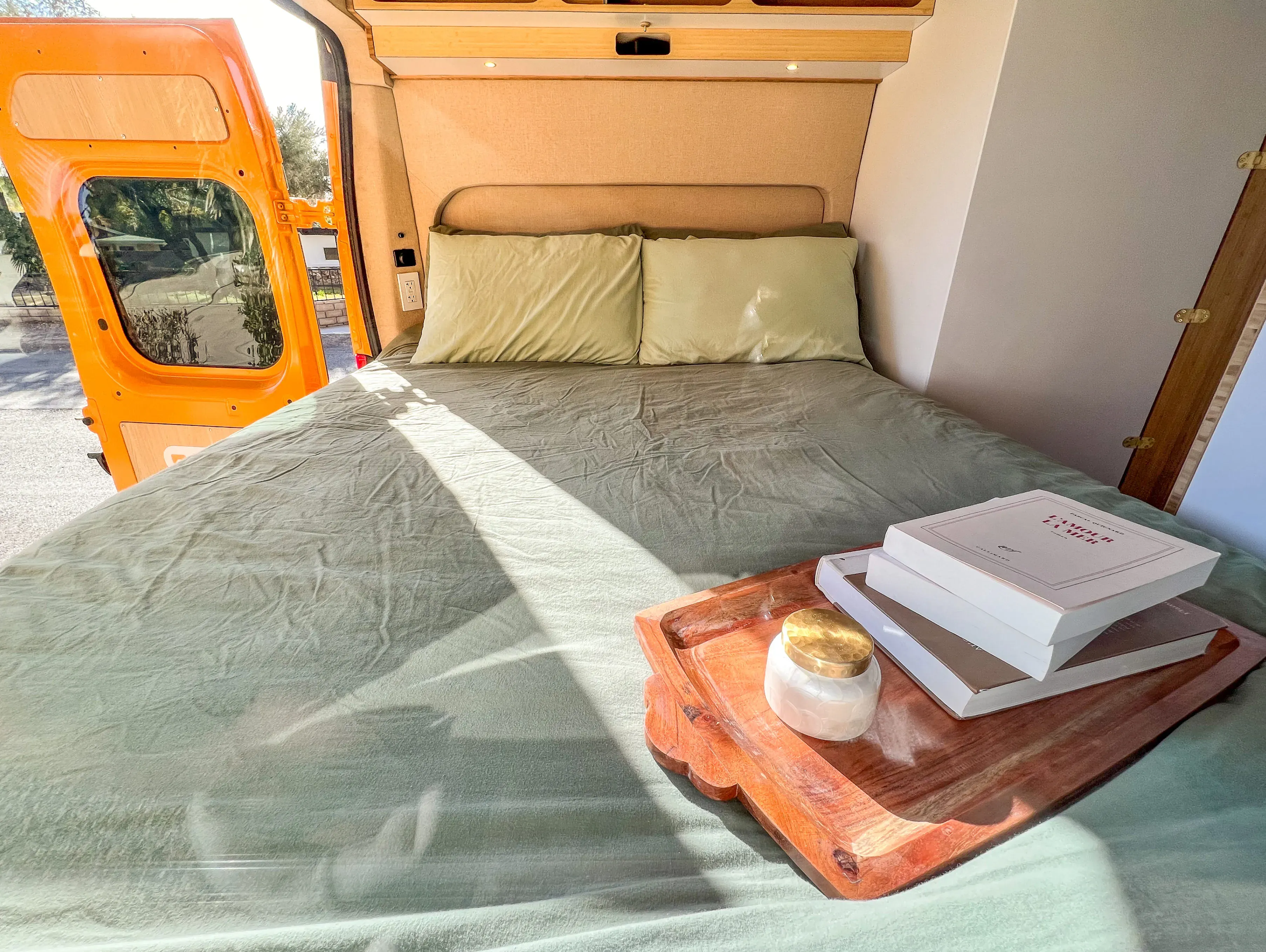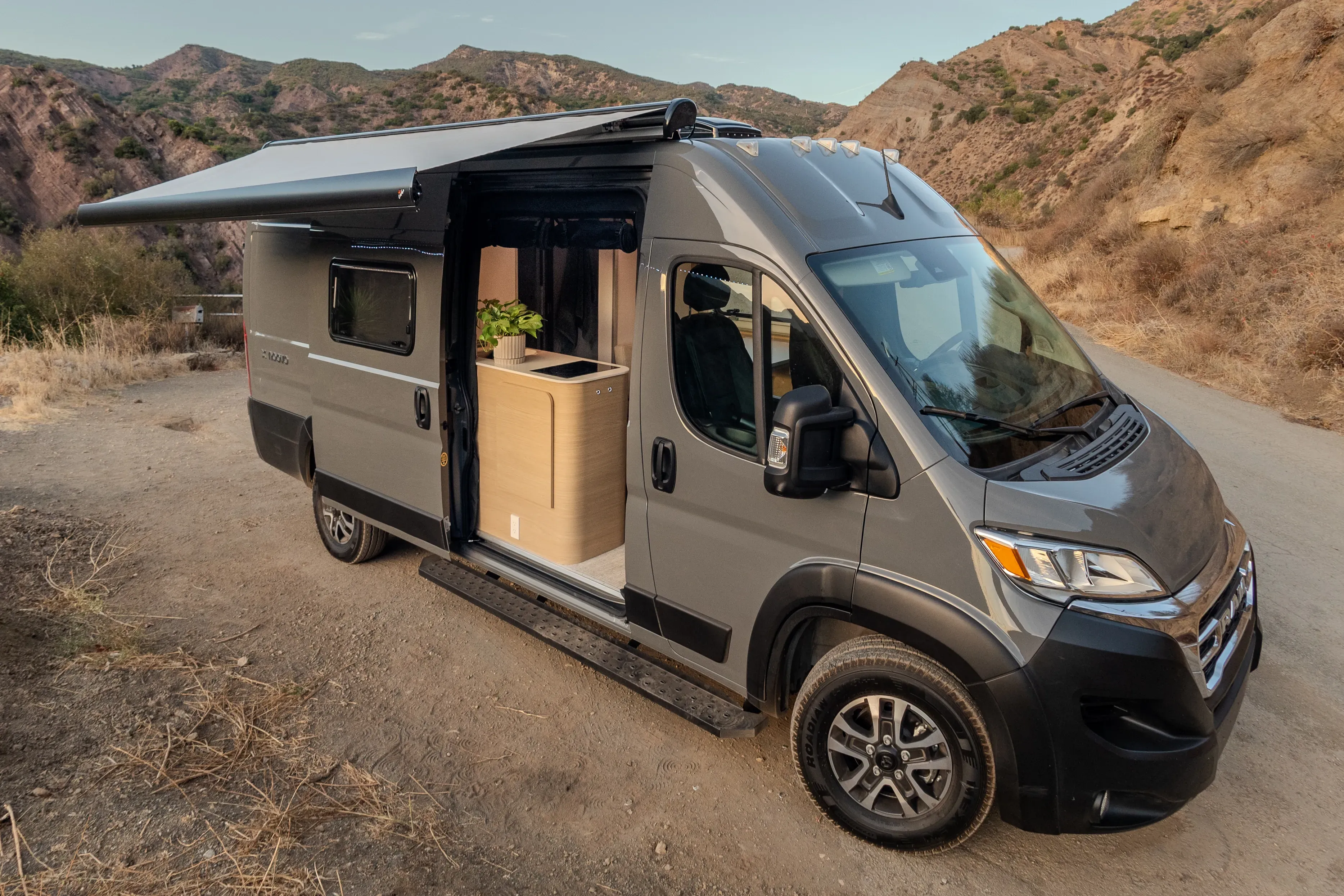📞 Schedule your online consultation here
RAM ProMaster vs Ford Transit:
Camper Van Chassis Comparison
The RAM ProMaster and Ford Transit are two of the most popular chassis choices for camper van conversions, each offering unique advantages.

The most notable difference is their drivetrain: the ProMaster is front-wheel drive, while the Transit is rear-wheel drive with an all-wheel drive option in newer models.
For most people living or traveling extensively in vans, factors like interior space, fuel efficiency, and maintenance costs play a crucial role in daily life. The ProMaster offers a more conversion-friendly interior with its boxy shape, while the Transit provides a balance of drivability and space. Neither offers a true 4x4 option, but this is often unnecessary for the majority of van-based adventures.
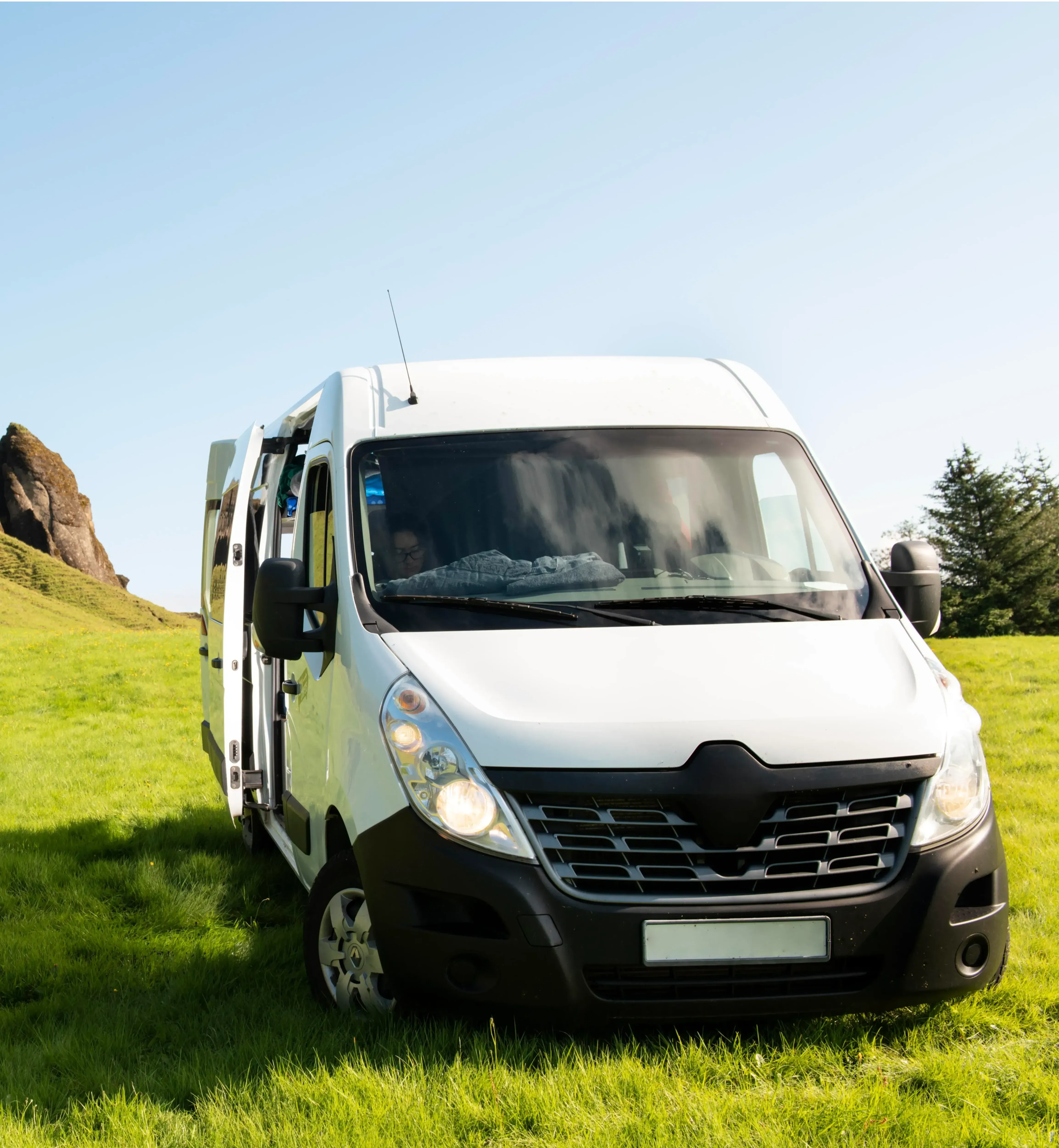
The Ford Transit
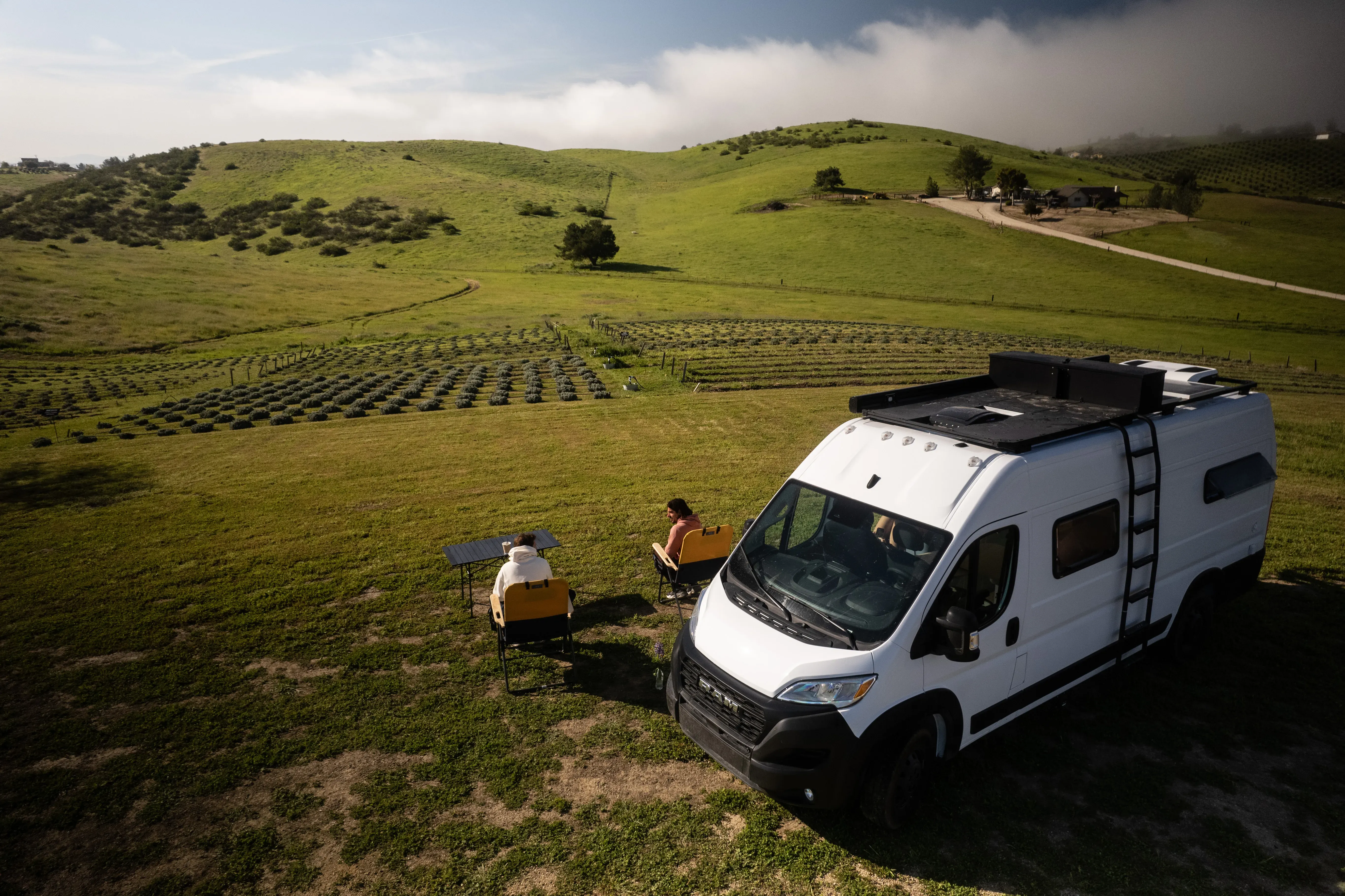
The Promaster chassis
RAM ProMaster vs Ford Transit
Chassis Features
Features | RAM ProMaster | Ford Transit |
|---|---|---|
Drive Configuration | Front-wheel drive | Rear-wheel drive (AWD available in newer models) |
Interior Shape | Boxy, very conversion-friendly | Slightly curved walls, still conversion-friendly |
Cost | Affordable | Slightly higher initial cost |
Serviceability | Widespread, easy maintenance | Widespread, easy maintenance |
Fuel Options | Gasoline only | Gasoline (diesel in some markets) |
The most significant difference between the ProMaster and Transit is their drivetrain. The ProMaster's front-wheel drive offers excellent maneuverability and traction in most conditions, while the Transit's rear-wheel drive (with AWD in newer models) provides better handling with heavy loads and in some off-road situations.
Interior design also differs notably. The ProMaster's boxy shape maximizes interior space and simplifies conversions, allowing for easier installation of cabinets and fixtures. The Transit's slightly curved walls still offer good conversion potential but may require more custom work for a perfect fit.
Cost and maintenance are similar for both vehicles, with widespread service networks across North America. The ProMaster often has a slightly lower initial cost, but the difference is usually minimal.
At Noovo, we've found that both chassis offer excellent platforms for van conversions. The choice often comes down to personal preference in driving feel and specific interior layout needs.
Our designs focus on maximizing the strengths of each chassis, ensuring optimal livability regardless of the base vehicle chosen.
ProMaster vs Transit Detailed
Spec Sheet
Features | RAM ProMaster | Ford Transit |
|---|---|---|
Chassis | RAM ProMaster 3500 | Ford Transit 350 |
Engine | 3.6L V6 gasoline | 3.5L V6 gasoline or 2.0L I4 diesel (market dependent) |
Drivetrain | Front-wheel drive | Rear-wheel drive or AWD (newer models) |
Exterior Dimensions | Length: 19.5-20.7 ft, Width: 6.9 ft, Height: 8.3-9.1 ft | Length: 19.6-22.4 ft, Width: 6.8 ft, Height: 8.2-9.5 ft |
Interior Height | Up to 6.4 ft | Up to 6.7 ft |
Cargo Space | Up to 463 cu ft | Up to 487 cu ft |
Payload Capacity | Up to 4,680 lbs | Up to 5,110 lbs |
Towing Capacity | Up to 6,910 lbs | Up to 6,800 lbs |
Fuel Efficiency | 17-21 mpg combined | 15-20 mpg combined |
Starting Price | Around $38,000 | Around $38,000 |
Warranty | 3-year/36,000-mile basic, 5-year/60,000-mile powertrain | 3-year/36,000-mile basic, 5-year/60,000-mile powertrain |
The RAM ProMaster and Ford Transit offer distinct advantages in their specifications. The ProMaster, with its front-wheel drive, provides excellent maneuverability and a lower load floor, which can be beneficial for conversions. Its boxy shape maximizes interior space, making it easier to design efficient layouts.
The Transit, with its rear-wheel drive (and AWD option in newer models), offers better towing capacity and handling under heavy loads. It provides slightly more cargo space and interior height, which can be crucial for taller individuals or those planning more extensive builds.
Both vans offer similar fuel efficiency, with the ProMaster having a slight edge in its gasoline model. The Transit's available diesel engine can provide better fuel economy for long-distance travelers. Warranty coverage is identical for both vehicles, providing peace of mind for long-term ownership.
At Noovo, we've observed that the choice between these chassis often depends on the specific needs of the build.

Pricing & Value Comparison
Pricing Components | RAM ProMaster | Ford Transit |
|---|---|---|
Base Price | Starting around $38,000 | Starting around $38,000 |
Conversion Cost | $30,000 - $80,000 | $30,000 - $80,000 |
Financing Options | Available through dealers, flexible terms | Available through Ford Credit, flexible terms |
Estimated Monthly Payment | Typically $800 - $1,500 | Typically $800 - $1,500 |
Additional Costs | Upgrades, maintenance, fuel | Upgrades, maintenance, fuel |
Total Cost Over 5 Years | Estimated $80,000 - $150,000 | Estimated $80,000 - $150,000 |
Resale Value | Good | Good |
The RAM ProMaster and Ford Transit offer remarkably similar pricing structures, with base models of both vans starting around $38,000. This parity extends to conversion costs, which typically range from $30,000 to $80,000 for both vehicles, depending on the complexity and luxury level of the build.
Financing options are available for both vans, with monthly payments generally falling between $800 and $1,500, depending on the total cost of the converted vehicle and the terms of the loan. Over a five-year period, the total cost of ownership for either a ProMaster-based or Transit-based camper van is estimated at $80,000 to $150,000.
Additional costs such as upgrades, maintenance, and fuel are comparable for both vehicles. The ProMaster's slightly better fuel efficiency in its gasoline model may offer minor savings over time, while the Transit's diesel option could provide better economy for high-mileage users.
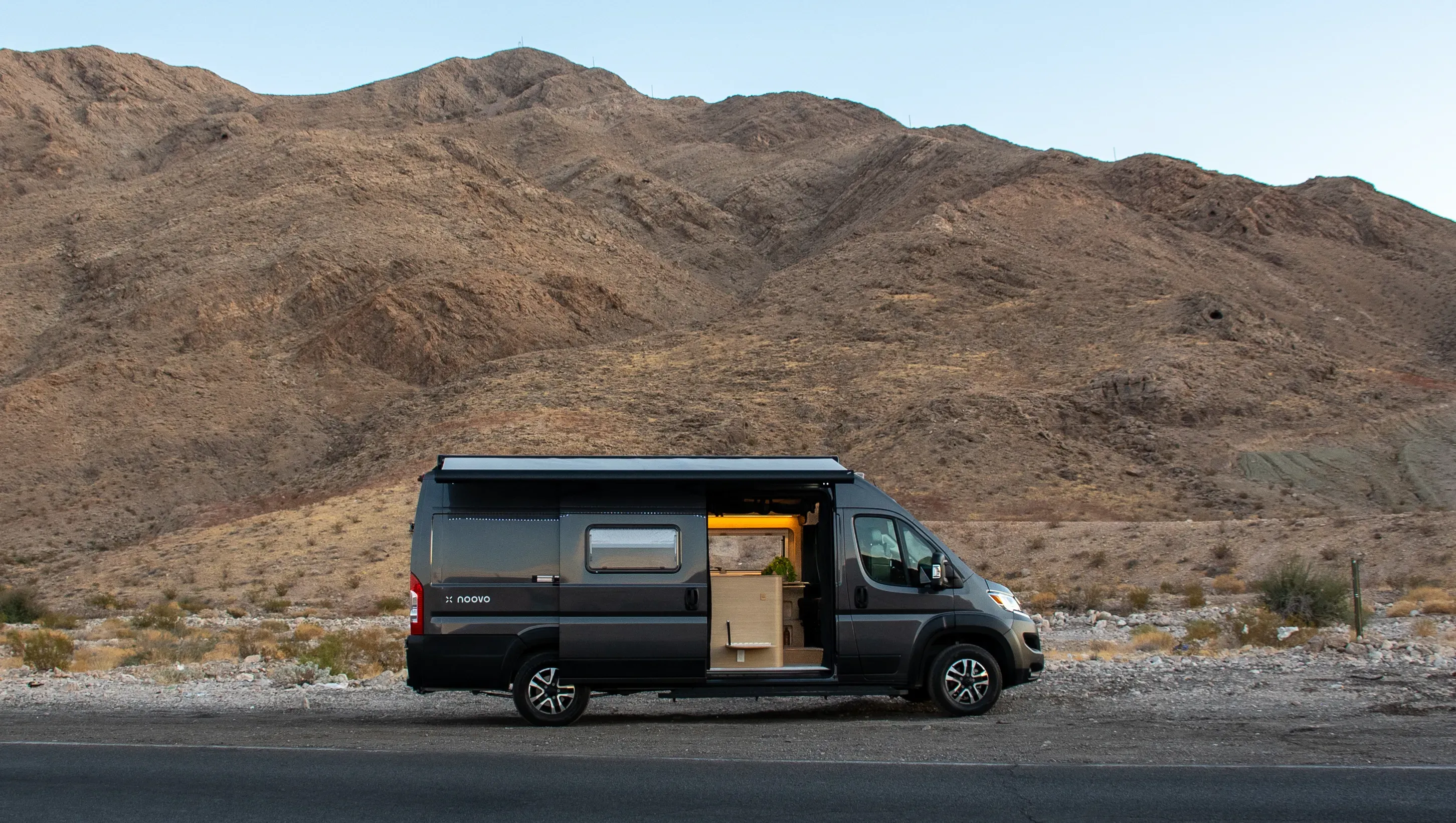
Our amazing Noovo Lite
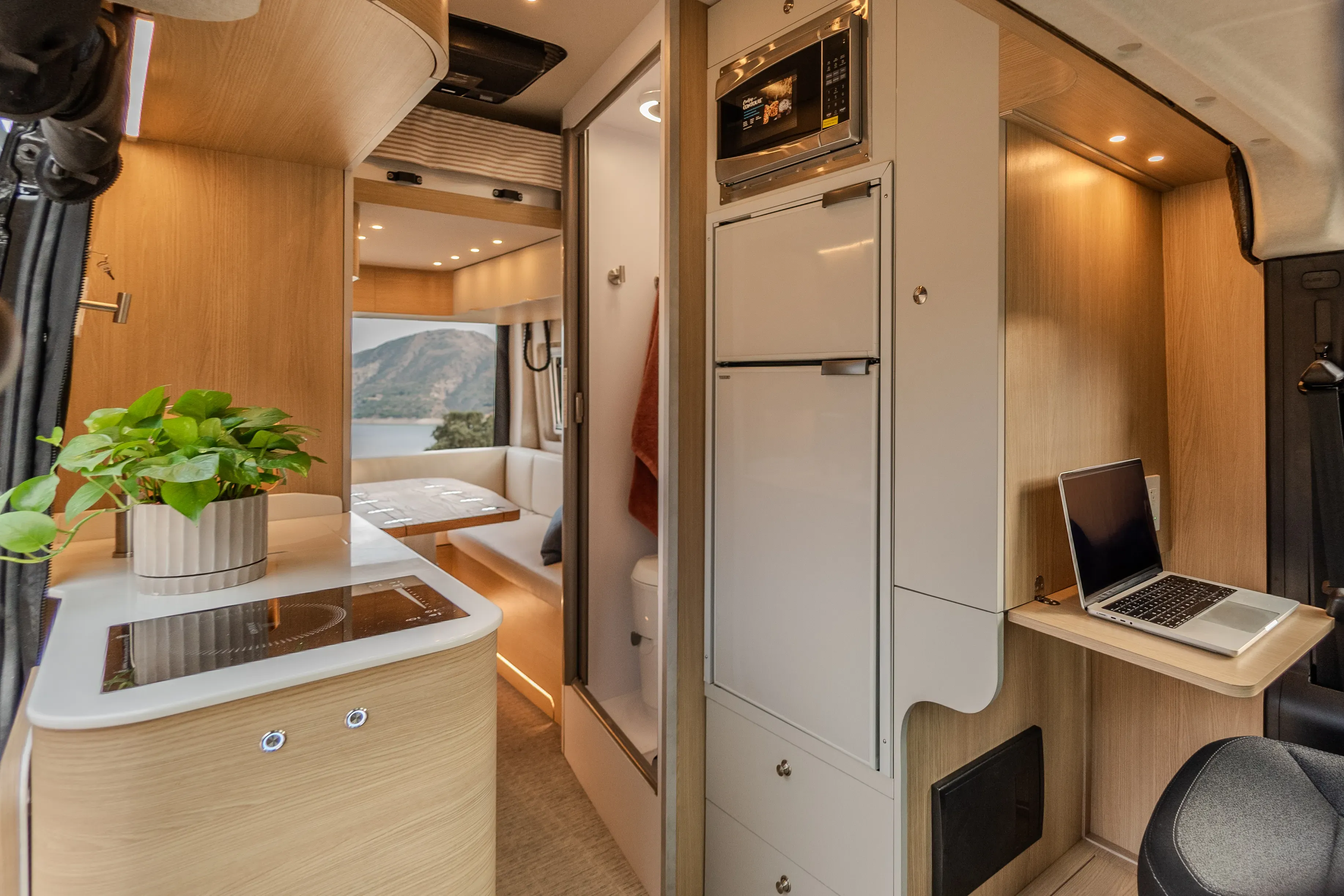
Our design Noovo Plus
Resale values for both vans are generally good, with factors like the quality of the conversion and overall maintenance playing a significant role in determining the long-term value.
RAM ProMaster
- Front-wheel drive for excellent maneuverability and traction - Boxy shape maximizes interior space for conversions - Slightly better fuel efficiency in gasoline models - Lower load floor height, beneficial for conversions and entry - Generally lower initial cost
- No diesel engine option in most markets - Slightly lower payload and towing capacity - Less suitable for heavy-duty towing - No all-wheel drive option
Ford Transit Pros
- Rear-wheel drive for better towing and handling with heavy loads - All-wheel drive option available in newer models - Slightly more cargo space and interior height - Diesel engine option available in some markets - Wider range of configuration options
- Curved walls can complicate some conversions - Slightly higher initial cost in some configurations - Rear-wheel drive may be less ideal in some winter conditions - Potentially lower fuel efficiency in base gasoline models
Frequently Asked Questions
Want to read more ?
Discover similar content with these recommended articles.

